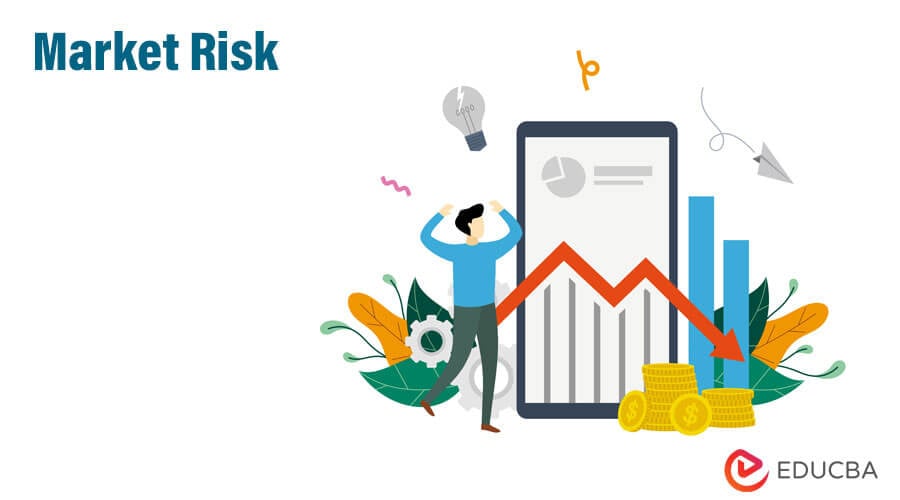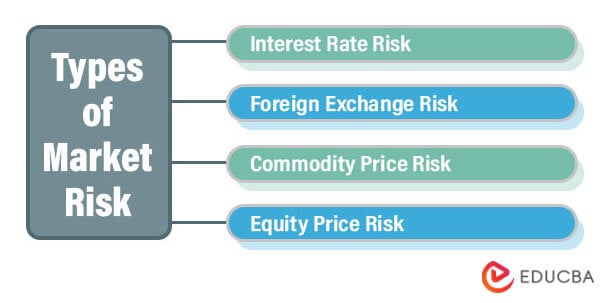Updated July 11, 2023

What is Market Risk?
The term “market risk” (MR) refers to the possibility that an investor might experience significant losses in the future due to factors that influence the performance of the overall market in which they operate.
Diversification cannot eliminate the MR, but it can only hedge it to a certain extent. Some of the most common examples of MR include recessions, changes in interest rates, political turmoil, terrorist attacks, and natural disasters. MR is also popularly known as systematic risk.
Explanation of Market Risk
The total investment risk broadly categorizes into MR and specific/ unsystematic risk. Unlike specific risk, MR can’t be linked to the performance of any particular company or industry; rather, it depends on the overall market’s performance. Hence, an investor must monitor the macroeconomic variables associated with the financial market. Examples of such macroeconomic variables include interest rates, inflation, fiscal deficits, and the balance of payments.
How to Hedge Market Risk?
Hedging refers to holding two or more opposing positions simultaneously to counterbalance any unanticipated losses from one position with some gains from another. As mentioned, hedging MR is just one of the ways to manage trading risk. Investors use different hedging strategies to safeguard themselves against unexpected market volatility.
Some investors prefer to use options trading as it allows them to hedge their positions through risk reversal and delta hedging. Some other investors opt for future contracts to hedge their positions on stocks, bonds, commodities, etc., by largely eliminating the uncertainty about the underlying security’s future price.
How to Calculate Market Risk?
An investment’s MR can calculate using Value-at-Risk (VaR) or Market risk premium.
- VaR indicates the maximum value (with a given probability)that an investment might lose given the current market conditions within a given period of time. Mathematically, it is represented as,
- The MR premium, on the other hand, provides a quantitative measure of the additional return that the market participants demand owing to the higher risk borne by them. Mathematically, it is represented as,
Examples
Some of the examples are:
Example #1
Let us take the example of a portfolio of $ 1,000,000 with a daily standard deviation of 2.50%over the last one year. Calculate the daily VaR of the portfolio at a confidence interval of 95%.
Solution:
- Given, Portfolio value = $1,000,000
- Standard deviation = 2.50%
- Z-score at 95% confidence interval = 1.65
Now, the daily VaR of the portfolio at a 95% confidence interval can calculate as,
VaR = Portfolio Value * Z-Score at Given Confidence Interval * Standard Deviation
- VaR = $1,000,000 * 1,65 * 2.50%
- VaR = $41,250
Therefore, the daily VaR of the portfolio at a 95% confidence interval is $41,250.
Example #2
Let us take the example of a stock with an expected rate of return of 7% while the rate of return of a Treasury bond is 2%. Determine the MR premium of the stock.
Solution:
- Given, Expected return = 7%
- The risk-free rate of return (Treasury bond) = 2%
Now, the MR premium of the stock can calculate as,
Market Risk Premium = Expected Return – Risk-Free Rate of Return
- Market Risk Premium = 7% – 2%
- Market Risk Premium = 5%
Therefore, the MR premium of the stock is 5%.
Types of Market Risk
There are four major types of MR – Interest rate risk, Foreign exchange risk, commodity price risk, and Equity price risk.
- Interest Rate Risk: This type of risk arises when the value of security plummets due to fluctuations in the prevailing and long-term interest rates. Interest rate risk can be further broken down into yield curve, basis, repricing, and options risk.
- Foreign Exchange Risk: This type of risk arises from fluctuations witnessed in the currency exchange rates, domestic currency vis-à-vis foreign currency.
- Commodity Price Risk: This type of risk arises out of variabilities in the prices of commodities, such as gold, silver, crude, etc. Commodity price risk affects not only multinational companies but also ordinary people.
- Equity Price Risk: This type of risk refers to fluctuations in stock prices. Equity price risk is a very important part of the overall MR.
Indicators of Market Risk
The following are some of the leading indicators of an MR situation:
- High implied market volatility
- Widening of spreads of high-yield bonds vis-à-vis Treasury bonds
- Flattening of the Treasury bond’s yield curve
- Weakening of some major global currency
Measuring Market Risk
Two major methods can be used to measure market risk -VaR and Beta.
- VaR is a statistical method applied over a specified period to estimate the extent of the maximum potential loss of portfolio value and the probability of occurrence of that loss.
- Betaindicatesa stock’s volatility on the basis of its past performance vis-à-vis the overall market.
Advantages
- The concept of MR helps in understanding the volatilities of financial products much better.
- It also helps investors to determine the real return made on an investment.
Disadvantages
- Market risk can’t be eliminated entirely but can only be hedged at best. The hedging also comes at a significant cost and its own set of risks.
- It is very challenging to manage MR in times of recession or cyclical changes in the economy.
Conclusion
So, market risk affects the overall market and can’t be eliminated through diversification. However, investors can measure the market risk using the available methods and then hedge against the MR, which is the best possible way.
Recommended Articles
This is a guide to Market Risk. Here we discuss the introduction, how to calculate market risk, and advantages and disadvantages. You may also have a look at the following articles to learn more –


